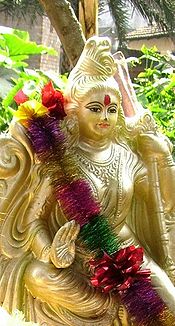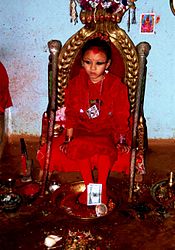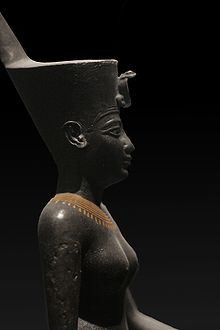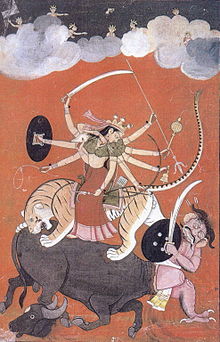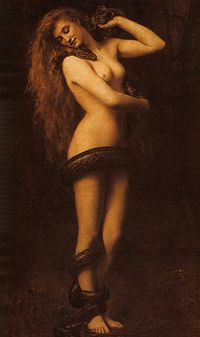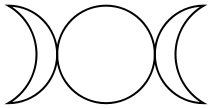- Goddess
-
A goddess is a female deity. In some cultures goddesses are associated with Earth, motherhood, love, and the household. In other cultures, goddesses also rule over war, death, and destruction as well as healing.
Of the existing major religions today, Hinduism is the only religion where the sacred feminine occupies a central place in prayer and worship. Sacred Feminine or Shaktism is one of the three major Hindu denominations of worship along with Vishnu and Shiva.
The primacy of a monotheistic or near-monotheistic "Great Goddess" is advocated by some modern matriarchists as a female version of, preceding, or analogue to, the Abrahamic God associated with the historical rise of monotheism in the Mediterranean Axis Age.
Some currents of Neopaganism, in particular Wicca, have a bitheistic concept of a single goddess and a single god, who in hieros gamos represent a united whole. Polytheistic reconstructionists focus on reconstructing polytheistic religions, including the various goddesses and figures associated with indigenous cultures.
The noun goddess is a secondary formation, combining the Germanic god with the Latinate -ess suffix. It is first attested in Middle English, from about 1350.[1]
Contents
Types
Earth or Mother goddesses
Joseph Campbell in The Power of Myth, a 1988 interview with Bill Moyers,[2] links the image of the Earth or Mother Goddess to symbols of fertility and reproduction.[3] For example, Campbell states that, "There have been systems of religion where the mother is the prime parent, the source... We talk of Mother Earth. And in Egypt you have the Mother Heavens, the Goddess Nut, who is represented as the whole heavenly sphere".[4] Campbell continues by stating that the correlation between fertility and the Goddess found its roots in agriculture:
- Bill Moyers: But what happened along the way to this reverence that in primitive societies was directed to the Goddess figure, the Great Goddess, the mother earth- what happened to that?
- Joseph Campbell: Well that was associated primarily with agriculture and the agricultural societies. It has to do with the earth. The human woman gives birth just as the earth gives birth to the plants...so woman magic and earth magic are the same. They are related. And the personification of the energy that gives birth to forms and nourishes forms is properly female. It is in the agricultural world of ancient Mesopotamia, the Egyptian Nile, and in the earlier planting-culture systems that the Goddess is the dominant mythic form.[5]
Campbell also argues that the image of the Virgin Mary was derived from the image of Isis and her child Horus: "The antique model for the Madonna, actually, is Isis with Horus at her breast".[6]
Love goddesses
Main article: Love goddessHistorical polytheism
Ancient Near East
Ancient Africa (Egypt)
Main article: Netjeret- Goddesses of the Ennead of Heliopolis: Tefnut, Nut, Nephthys, Isis
- Goddesses of the Ogdoad of Hermopolis: Naunet, Amaunet, Kauket, Hauhet; originally a cult of Hathor
- Satis and Anuket of the triad of Elephantine
Mesopotamia
Ishtar (Inanna) was the main goddess of Babylonia and Assyria. Other Mesopotamian goddesses include Ninhursag, Ninlil, Antu
Canaan
Main article: BaalatGoddesses of the Canaanite religion: Ba`alat Gebal, Astarte, Anat.
Pre-Islamic Arabia
In pre-Islamic Mecca the goddesses Uzza, al-Manāt and al-Lāt were known as "the daughters of god". Uzzā was worshipped by the Nabataeans, who equated her with the Graeco-Roman goddesses Aphrodite, Urania, Venus and Caelestis. Each of the three goddesses had a separate shrine near Mecca. Uzzā, was called upon for protection by the pre-Islamic Quraysh. "In 624 at the battle called "Uhud", the war cry of the Qurayshites was, "O people of Uzzā, people of Hubal!" (Tawil 1993).
According to Ibn Ishaq's controversial account of the Satanic Verses (q.v.), these verses had previously endorsed them as intercessors for Muslims, but were abrogated. Most Muslim scholars have regarded the story as historically implausible, while opinion is divided among western scholars such as Leone Caetani and John Burton, who argue against, and William Muir and William Montgomery Watt, who argue for its plausibility.
Indo-European traditions
Pre-Christian and pre-Islamic goddesses in cultures that spoke Indo-European languages.
Indo-Iranian
Ushas is the main goddess of the Rigveda. Prithivi, the Earth, also appears as a goddess. Rivers are also deified as goddesses.
Greco-Roman
- Eleusinian Mysteries: Persephone, Demeter, Baubo
- Aphrodite: Goddess of love, lust and beauty.
- Artemis: Goddess of the moon, fertility, childbirth, and the hunt. She is the protector of children and maidens and she is also a virgin goddess.
- Athena: Goddess of crafts, strategy, wisdom and war. Athena is also a virgin goddess.
- Cybele
- Eris: Goddess of discord (chaos).
- Hera: Goddess of family and marriage. She is the wife of Zeus and the queen of the Olympians. Mother of Ares.
- Hecate: Goddess of sorcery, crossroads and magic. Often considered an chthonic or lunar goddess. She is either portrayed as a single goddess or a triple goddess (maiden, woman, crone).
- Iris: Messenger of the gods.
- Nike: Goddess of victory. She is predominantly pictured with Zeus or Athena and sometimes Ares.
- Potnia Theron
- Selene: The original moon goddess but later gave her powers to Artemis. Her twin brother Helios is the sun god.
Celtic
Main article: Celtic pantheonGoddesses in Celtic polytheism:
- Celtic antiquity: Brigantia
- Gallo-Roman goddesses: Epona, Dea Matrona
- Goddesses of Insular (Welsh, Irish) mythology: Mórrígan-Nemain-Macha-Badb, Brigid, Ériu, Danu
- Yanet is the celtic goddess of sex, love and harmony.
Germanic
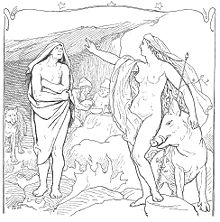 The goddess Freyja is nuzzled by the boar Hildisvíni while gesturing to Hyndla (1895) by Lorenz Frølich.
The goddess Freyja is nuzzled by the boar Hildisvíni while gesturing to Hyndla (1895) by Lorenz Frølich. Further information: List_of_Germanic_deities_and_heroes#Goddesses
Further information: List_of_Germanic_deities_and_heroes#GoddessesSurviving accounts of Germanic mythology and later Norse mythology contain numerous tales and mentions of female goddesses, female giantesses, and divine female figures. The Germanic peoples had altars erected to the "Mothers and Matrons" and held celebrations specific to them (such as the Anglo-Saxon "Mothers-night"), and various other female deities are attested among the Germanic peoples, such as Nerthus attested in an early account of the Germanic peoples, Ēostre attested among the pagan Anglo-Saxons and Sinthgunt attested among the pagan continental Germanic peoples. Examples of goddesses attested in Norse mythology include Frigg (wife of Odin, and the Anglo-Saxon version of whom is namesake of the modern English weekday Friday), Skaði (one time wife of Njörðr), Njerda (Scandinavian name of Nerthus, that also was married to Njörðr during Bronze Age, Freyja (wife of Óðr), Sif (wife of Thor), Gerðr (wife of Freyr), and personifications such as Jörð (earth), Sól (the sun), and Nótt (night). Female deities also play heavily into the Norse concept of death, where half of those slain in battle enter Freyja's field Fólkvangr, Hel receives the dead in her realm of the same name, and Rán receives those who die at sea. Other female deities such as the valkyries, the norns, and the dísir are associated with a Germanic concept of fate (Old Norse Ørlög, Old English Wyrd), and celebrations were held in their honor, such as the Dísablót and Disting.
Folk religion and animism
African religions
Further information: Traditional African religions and African diasporic religionsIn African and African diasporic religions, goddesses are often syncretized with Marian devotion, as in Ezili Dantor (Black Madonna of Częstochowa) and Erzulie Freda (Mater Dolorosa). There is also Buk, an Ethiopian goddess still worshipped in the southern regions. She represents the fertile aspect of women. So when a woman is having her period not only does it signify her submission to nature but also her union with the goddess.[citation needed] Another Ethiopian goddess is Atete—the goddess of spring and fertility. Farmers traditionally leave some of their products at the end of each harvesting season as an offering while their women sing traditional songs. A rare example of henotheism focused on a single Goddess is found among the Southern Nuba of Sudan. The Nuba conceive of the creator Goddess as the "Great Mother" who gave birth to earth and to mankind.[7]
Chinese folk religion
- Mazu is the goddess of the sea who protects fishermen and sailors, widely worshipped in the south-eastern coastal areas of China and neighbouring areas in Southeast Asia.
- The Goddess Weaver, daughter of the Celestial Mother, wove the stars and their light, known as "the Silver River" (what Westerners call "The Milky Way Galaxy"), for heaven and earth. She was identified with the star Westerners know as Vega.[8]
Hinduism
Main article: God and gender in HinduismHinduism is a complex of various belief systems that sees many gods and goddesses as being representative of and/or emanative from a single source, Brahman, understood either as a formless, infinite, impersonal monad in the Advaita tradition or as a dual god in the form of Lakshmi-Vishnu, Radha-Krishna, Shiva-Shakti in Dvaita traditions. Shaktas, worshippers of the Goddess, equate this god with Devi, the mother goddess. Such aspects of one god as male god (Shaktiman) and female energy (Shakti), working as a pair are often envisioned as male gods and their wives or consorts and provide many analogues between passive male ground and dynamic female energy.
For example, Brahma pairs with Sarasvati. Shiva likewise pairs with Parvati who later is represented through a number of Avatars (incarnations): Sati and the warrior figures, Durga and Kali. All goddesses in Hinduism are sometimes grouped together as the great goddess, Devi.A further step was taken by the idea of the Shaktis. Their ideology based mainly on tantras sees Shakti as the principle of energy through which all divinity functions, thus showing the masculine to be dependent on the feminine. Indeed, in the great shakta scripture known as the Devi Mahaamya, all the goddesses are shown to be aspects of one presiding female force, one in truth and many in expression, giving the world and the cosmos the galvanic energy for motion. It is expressed through both philosophical tracts and metaphor that the potentiality of masculine being is given actuation by the feminine divine. Local deities of different village regions in India were often identified with "mainstream" Hindu deities, a process that has been called "Sanskritization". Others attribute it to the influence of monism or Advaita which discounts polytheist or monotheist categorization.
While the monist forces have led to a fusion between some of the goddesses (108 names are common for many goddesses), centrifugal forces have also resulted in new goddesses and rituals gaining ascendance among the laity in different parts of Hindu world. Thus, the immensely popular goddess Durga was a pre-Vedic goddess who was later fused with Parvati, a process that can be traced through texts such as Kalika Purana (10th century), Durgabhaktitarangini (Vidyapati 15th century), Chandimangal (16th century) etc.
Abrahamic religions
Judaism
According to Zohar, Lilith is the name of Adam's first wife, who was created at the same time as Adam. She left Adam and refused to return to the Garden of Eden after she mated with archangel Samael.[9] Her story was greatly developed, during the Middle Ages, in the tradition of Aggadic midrashim, the Zohar and Jewish mysticism.[10]
The Zohar tradition has influenced Jewish folkore, which postulates God created Adam to marry a woman named Lilith. Outside of Jewish tradition, Lilith was associated with the Mother Goddess, Inanna – later known as both Ishtar and Asherah. In The Epic of Gilgamesh, Gilgamesh was said to have destroyed a tree that was in a sacred grove dedicated to the goddess Ishtar/Inanna/Asherah. Lilith ran into the wilderness in despair. She then is depicted in the Talmud and Kabbalah as first wife to God's first creation of man, Adam. In time, as stated in the Old Testament, the Hebrew followers continued to worship "False Idols", like Asherah, as being as powerful as God. Jeremiah speaks of his (and God's) displeasure at this behavior to the Hebrew people about the worship of the goddess in the Old Testament. Lilith is banished from Adam and God's presence when she is discovered to be a "demon" and Eve becomes Adam's wife. Lilith then takes the form of the serpent in her jealous rage at being displaced as Adam's wife. Lilith as serpent then proceeds to trick Eve into eating the fruit from the tree of knowledge and in this way is responsible for the downfall of all of mankind. It is worthwhile to note here that in religions pre-dating Judaism, the serpent was known to be associated with wisdom and re-birth (with the shedding of its skin).
The following female deities are mentioned in prominent Hebrew texts:Christianity
In Christianity, worship of any other deity besides the Trinity was deemed heretical, but veneration for Mary, the mother of Jesus Christ, as an especially privileged saint— though not as a deity— has continued since the beginning of the Catholic faith.[citation needed] Mary is venerated as the Mother of God, Queen of Heaven, Mother of the Church, Our Lady, Star of the Sea, and other lofty titles. Marian devotion similar to this kind is also found in Eastern Orthodoxy and sometimes in Anglicanism, though not in the majority of denominations of Protestantism.
 Virgin Sophia design on a Harmony Society doorway in Harmony, Pennsylvania, carved by Frederick Reichert Rapp (1775–1834).
Virgin Sophia design on a Harmony Society doorway in Harmony, Pennsylvania, carved by Frederick Reichert Rapp (1775–1834).
In some Christian traditions (like the Orthodox tradition), Sophia is the personification of either divine wisdom (or of an archangel) which takes female form. She is mentioned in the first chapter of the Book of Proverbs.
In Mysticism, Gnosticism, as well as some Hellenistic religions, there is a female spirit or goddess named Sophia who is said to embody wisdom and who is sometimes described as a virgin. In Roman Catholic mysticism, Hildegard of Bingen celebrated Sophia as a cosmic figure both in her writing and art. Within the Protestant tradition in England, 17th Century Mystic, Universalist and founder of the Philadelphian Society Jane Leade wrote copious descriptions of her visions and dialogues with the "Virgin Sophia" who, she said, revealed to her the spiritual workings of the universe. Leade was hugely influenced by the theosophical writings of 16th Century German Christian mystic Jakob Böhme, who also speaks of the Sophia in works such as The Way to Christ.[11] Jakob Böhme was very influential to a number of Christian mystics and religious leaders, including George Rapp and the Harmony Society.
Feminism and Neopaganism
Goddess movement
At least since first-wave feminism in the United States, there has been interest in analyzing religion to see if and how doctrines and practices treat women unfairly, as in Elizabeth Cady Stanton's The Woman's Bible. Again in second-wave feminism in the U.S., as well as in many European and other countries, religion became the focus of some feminist analysis in Judaism, Christianity, and other religions, and some women turned to ancient goddess religions as an alternative to Abrahamic religions (Womanspirit Rising 1979; Weaving the Visions 1989). Today both women and men continue to be involved in the Goddess movement (Christ 1997). The popularity of organizations such as the Fellowship of Isis attest to the continuing growth of the religion of the Goddess throughout the world.
While much of the attempt at gender equity in mainstream Christianity (Judaism never recognized any gender for God) is aimed at reinterpreting scripture and degenderizing language used to name and describe the divine (Ruether, 1984; Plaskow, 1991), there are a growing number of people who identify as Christians or Jews who are trying to integrate goddess imagery into their religions (Kien, 2000; Kidd 1996,"Goddess Christians Yahoogroup").
Sacred feminine
The term "sacred feminine" was first coined in the 1970s, in New Age popularizations of the Hindu Shakti. It was further popularized during the 1990s by Andrew Harvey and others, and entered mainstream pop culture in 2003 with Dan Brown's The Da Vinci Code.
Wicca
In Wicca "the Goddess" is a deity of prime importance, along with her consort the Horned God. Within many forms of Wicca the Goddess has come to be considered as a universal deity, more in line with her description in the Charge of the Goddess, a key Wiccan text. In this guise she is the "Queen of Heaven", similar to Isis; she also encompasses and conceives all life, much like Gaia. Much like Isis and certain late Classical conceptions of Selene,[12] she is held to be the summation of all other goddesses, who represent her different names and aspects across the different cultures. The Goddess is often portrayed with strong lunar symbolism, drawing on various cultures and deities such as Diana, Hecate and Isis, and is often depicted as the Maiden, Mother and Crone triad popularised by Robert Graves (see Triple Goddess below). Many depictions of her also draw strongly on Celtic goddesses. Some Wiccans believe there are many goddesses, and in some forms of Wicca, notably Dianic Wicca, the Goddess alone is worshipped, and the God plays very little part in their worship and ritual.
Goddesses or demi-goddesses appear in sets of three in a number of ancient European pagan mythologies; these include the Greek Erinyes (Furies) and Moirae (Fates); the Norse Norns; Brighid and her two sisters, also called Brighid, from Irish or Keltoi mythology.
Robert Graves popularised the triad of "Maiden" (or "Virgin"), "Mother" and "Crone", and while this idea did not rest on sound scholarship, his poetic inspiration has gained a tenacious hold. Considerable variation in the precise conceptions of these figures exists, as typically occurs in Neopaganism and indeed in pagan religions in general. Some choose to interpret them as three stages in a woman's life, separated by menarche and menopause. Others find this too biologically based and rigid, and prefer a freer interpretation, with the Maiden as birth (independent, self-centred, seeking), the Mother as giving birth (interrelated, compassionate nurturing, creating), and the Crone as death and renewal (holistic, remote, unknowable) — and all three erotic and wise.
Metaphorical use
The term "goddess" has also been adapted to poetic and secular use as a complimentary description of a non-mythological woman.[13] The OED notes 1579 as the date of the earliest attestation of such figurative use, in Lauretta the diuine Petrarches Goddesse.
Shakespeare had several of his male characters address female characters as goddesses, including Demetrius to Helena in A Midsummer Night's Dream ("O Helen, goddess, nymph, perfect, divine!"), Berowne to Rosaline in Love's Labour's Lost ("A woman I forswore; but I will prove, Thou being a goddess, I forswore not thee"), and Bertram to Diana in All's Well That Ends Well. Pisanio also compares Imogen to a goddess to describe her composure under duress in Cymbeline.
See also
- Anima (Jung)
- Gender of God
- Gingira
- Goddess movement
- Mother goddess
- Heavenly Mother
- Sophia
- Ochre
- Venus figurines
- Matriarchy
- The Myth of Matriarchal Prehistory
- Heavenly Mother
Notes
- ^ Barnhart (1995:323).
- ^ first broadcast on PBS in 1988 as a documentary, The Power of Myth was also released in the same year as a book created under the direction of the late Jacqueline Kennedy Onassis
- ^ Chapter 6, "The Gift of the Goddess" and Episode 5, "Love and the Goddess" [1]
- ^ p. 165, 1988, first edition
- ^ pp.166–7, (1988, first edition)
- ^ p. 176, 1988, first edition
- ^ Mbiti, J.S., Introduction to African Religion, Oxford, 1975, p. 53.
- ^ Jung Chang, Wild Swans: Three Daughters of China, New York: Touchstone, 2003, reprint, GlobalFlair, 1991, p. 429, accessed 2 Nov 2009
- ^ Samael & Lilith
- ^ Tree of souls: the mythology of Judaism, By Howard Schwartz, page 218
- ^ Böhme, Jacob; William Law, trans. (1622 (1764)). The Way to Christ. Pater-noster Row, London: M. Richardson. http://www.passtheword.org/DIALOGS-FROM-THE-PAST/waychrst.htm.
- ^ Betz, Hans Dieter (ed.) (1989). The Greek Magical Papyri in Translation : Including the Demotic Spells : Texts. University of Chicago Press.
- ^ OED: "Applied to a woman. one's goddess: the woman whom one ‘worships’ or devotedly admires."
References
- Dexter, Miriam Robbins, and Victor Mair (2010). Sacred Display: Divine and Magical Female Figures of Eurasia. Cambria Press.
- Barnhart, Robert K (1995). The Barnhart Concise Dictionary of Etymology: the Origins of American English Words. HarperCollins. ISBN 0-06-270094-7
- Gorshunova . Olga V.(2008), Svjashennye derevja Khodzhi Barora…, ( Sacred Trees of Khodzhi Baror: Phytolatry and the Cult of Female Deity in Central Asia) in Etnoragraficheskoe Obozrenie, n° 1, pp. 71-82. ISSN 0869-5415. (Russian).
Theism List of philosophies Deity (Divinity · Numen · Male · Female · List) · Singular God (Existence · Gender) · Binitarianism · Deism · Dystheism · Henotheism · Kathenotheism · Monolatrism · Monotheism · Mysticism · Nontheism · Pandeism · Panentheism · Pantheism · Polydeism · Polytheism · Spiritualism · TheopanismTheological thought Abrahamism · Acosmism · Agnosticism · Animism · Antireligion · Atheism · Deism · Dharmism · Discordianism - Dualism · Esotericism · Feminist theology · Gnosticism · Henotheism · Immanence · Monism · Monotheism · Mysticism · New Age · New Thought · Nondualism · Pandeism · Pantheism · Polytheism · Process theology · Rastafari movement - Religious naturalism · Shamanism · Shramanism · Taoic · Theism · Thelema - Transcendence · more
Categories:- Deities by gender
- Goddesses
- Polytheism
Wikimedia Foundation. 2010.

